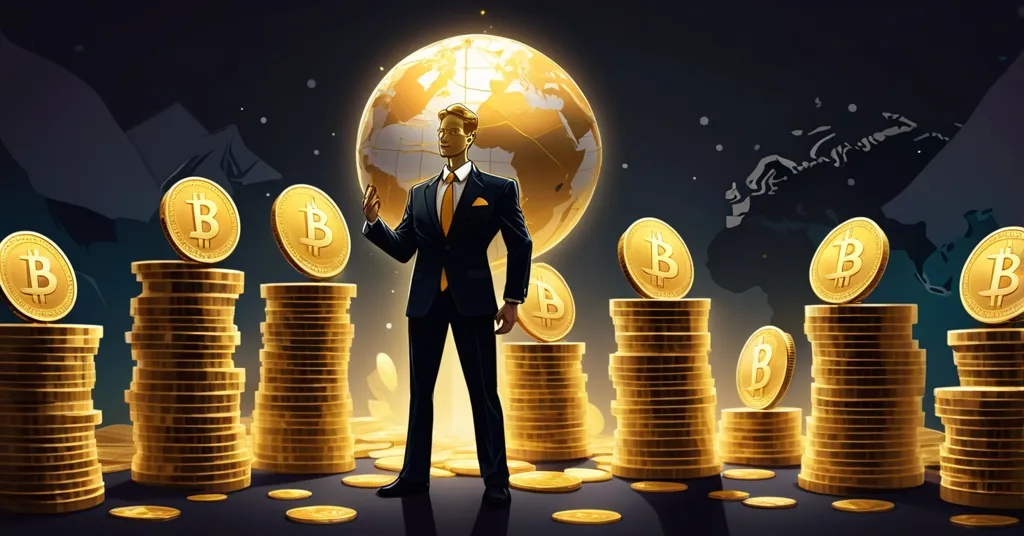Trump Family Nets $864M in Crypto: Innovation or Ethical Quagmire?

Trump Family Cashes In: Nearly $1 Billion from Crypto Ventures as Token Sales Soar
The Trump family has stormed into the cryptocurrency arena, amassing a staggering $864 million in earnings during the first half of 2024 alone, a seismic leap from the $51 million earned the prior year. This near-billion-dollar haul, driven largely by token sales, places them at the center of a polarizing debate about innovation, ethics, and the future of finance.
- Massive Profits: Trump Organization nets $864M in H1 2024, over 90% from crypto ventures.
- World Liberty Financial (WLFI): Launched in September 2024, no platform yet, but huge token sales.
- Ethical Concerns: Foreign investments raise questions of influence over innovation.
Skyrocketing Earnings: Breaking Down the Numbers
The financial pivot of the Trump family into digital assets is nothing short of dramatic. With total crypto earnings nearing $1 billion, the bulk—$864 million—came in just six months of 2024. To put that into perspective, it’s a 16-fold increase from the previous year’s $51 million. The cash flow stems primarily from two sources: token sales for World Liberty Financial (WLFI), which brought in $463 million, and the $TRUMP meme coin, adding another $336 million between January and June. For those new to the space, meme coins are typically speculative digital assets often tied to internet trends or personalities, rarely offering real utility. Seeing such hefty sums tied to one bearing a political name is, frankly, a head-scratcher.
Diving into the big-ticket investments, a group called Aqua1 Foundation, claiming connections to the United Arab Emirates, shelled out $100 million for WLFI tokens on June 26, 2024, marking one of the largest single purchases at the time. Then there’s Alt5 Sigma, a Nasdaq-listed blockchain services firm, which dumped a whopping $750 million for a mere 7.5% stake in WLFI tokens. That deal funneled roughly $500 million straight to the Trump family. Looking at token ownership, the distribution screams red flags: of the 50 largest WLFI token wallets—digital accounts that hold these assets—36 are likely controlled by overseas buyers, holding $804 million worth. Only four trace back to U.S. investors, with Alt5 Sigma dominating at $781 million. That heavy foreign tilt isn’t just a statistic; it’s a neon warning sign in a sector already plagued by murky dealings.
WLFI: Hype Without a Product to Show
At the heart of this financial frenzy is World Liberty Financial (WLFI), launched in September 2024 with bold promises of a peer-to-peer finance platform to shake up how money moves in America. The vision, as pitched, includes a crypto deposit app, a borrowing service, and even a stablecoin named USD1—think of stablecoins as digital dollars pegged to real-world currency to avoid the wild price swings of assets like Bitcoin. Yet, here’s the stark reality: there’s no working platform. Absolutely nothing tangible despite the hundreds of millions raised. Early investors have called the underlying tech “rudimentary,” barely past a conceptual sketch. Compare that to robust blockchain ecosystems like Ethereum, which powers thousands of decentralized apps via smart contracts—complex, self-executing agreements coded on the blockchain. WLFI’s current state is more akin to a placeholder website than a revolutionary fintech tool.
The token’s price history tells a brutal story of speculation. On launch day, September 1, 2024, WLFI tokens jumped from $0.31 to $0.46, only to crater 65% within three days to around $0.14. That kind of volatility is a hallmark of hype-driven crypto assets, where early “whales”—big holders who can sway prices with bulk trades—often profit while smaller investors get burned. For now, WLFI’s proposed USD1 stablecoin remains a blip compared to market leaders like USDT or USDC, which boast billions in circulation. Without a functional product, investors are essentially betting on a dream—or something far less noble.
Ethical Minefield: Foreign Funds and Dubious Ties
Peering into who’s funding this venture reveals a tangle of ethical dilemmas. Eric Trump took the stage in Dubai in May 2024, pitching WLFI to high-rollers with a minimum investment of $20 million. His angle was clear and biting, targeting traditional finance’s shortcomings.
“Traditional banks are inefficient and… World Liberty would represent the ‘future of finance’ in America.”
Yet, alongside him was Guren “Bobby” Zhou, a Chinese businessman linked to a U.K. money laundering investigation and owing 19.4 million yuan in unpaid loans in China, per reported allegations. That’s hardly the kind of partner to inspire confidence in a project already lacking substance. The heavy foreign investment—over $800 million in WLFI tokens held overseas—fuels speculation beyond mere profit-seeking. Law professor and ethics expert Kathleen Clark offered a damning take on the motivations at play.
“These people are not pouring money into the coffers of the Trump family business because of the brothers’ acumen. They are doing it because they want freedom from legal constraints and impunity that only the president can deliver.”
Her words cut to the bone: this might not be about blockchain or decentralization at all. It could be a high-stakes game of political influence, leveraging crypto’s regulatory gray zones to skirt accountability. In a space built on the ethos of transparency, that stench is hard to ignore.
What It Means for Crypto’s Future
The Trump family’s dive into digital assets mirrors a wider trend of high-profile figures—politicians, celebrities, and influencers—rushing to cash in on crypto’s speculative boom. Think back to Kim Kardashian’s entanglement with EthereumMax, a token that tanked amid SEC scrutiny, or Justin Sun’s relentless promotion of Tron, often criticized as more hype than substance. WLFI isn’t an isolated stunt; it’s part of a pattern where fame and clout drive token sales over tangible innovation. For Bitcoin purists, this is a double-edged sword. On one hand, such mainstream attention could drag crypto closer to household acceptance, much like Bitcoin’s early skepticism gave way to begrudging respect. On the other, scandals and half-baked projects risk painting the entire space as a digital Wild West, undermining the legitimate fight for financial sovereignty.
As champions of decentralization, we see the potential here. Disrupting inefficient systems—like the banking behemoths Eric Trump railed against—is why Bitcoin was born. But let’s not kid ourselves: selling tokens without a product isn’t accelerationism; it’s a cash grab. While Ethereum and other protocols carve out niches with smart contracts and decentralized apps, WLFI’s current trajectory feels more like a digital lottery than a pillar of the future. Could it eventually deliver? Maybe. But right now, it’s a billion-dollar question mark with some unsavory baggage.
Let’s play devil’s advocate for a moment. Some might argue the Trump family’s crypto push is a gutsy move to challenge traditional finance, flaws and all. It’s true that shaking up the status quo often starts with messy, imperfect steps—Bitcoin itself faced endless “scam” accusations in its infancy. Yet, when the tech is nonexistent and the optics scream opportunism, that defense feels flimsy. This isn’t about effective progress; it’s about who profits while the house of cards stands.
Key Questions Unpacked
- What’s behind the Trump family’s staggering crypto profits?
Pure token sales—$463 million from WLFI and $336 million from the $TRUMP meme coin in six months, fueled by massive investments and speculative hype, much of it from foreign buyers. - Why are foreign investors so heavily involved in WLFI?
Overseas wallets hold over $800 million in tokens, possibly driven by speculation or, as critics suggest, a desire for political leverage rather than belief in the project’s tech. - Are there serious ethical issues with these ventures?
Absolutely—investments tied to potential influence, as Kathleen Clark warns, clash with crypto’s decentralized ideals and raise concerns about exploitation of regulatory gaps. - Why hasn’t WLFI delivered a working platform yet?
Despite the money raised, the tech remains basic at best, leaving backers with promises instead of products, a glaring gap between hype and reality. - What risks do WLFI’s price swings pose to investors?
A 65% crash in days signals high danger—smaller players could lose big while early sellers, potentially including insiders, walk away with gains. - Does this help or hurt cryptocurrency adoption?
It’s a mixed bag: visibility might draw normies in, but scandals and unfinished projects could reinforce distrust, stalling the broader mission of financial freedom.
Stepping back, the Trump family’s crypto ventures encapsulate the chaotic brilliance and grime of this space. There’s undeniable potential in drawing mainstream eyes to decentralization—a win for Bitcoin’s long game. Yet, the lack of a working product, ties to questionable figures, and whiffs of political maneuvering remind us why so many still view crypto as scam central. We’re not here to peddle fairy tales or hype baseless tokens. WLFI might one day match its lofty “future of finance” claims, but for now, it’s a flashy mirage with a hefty price tag. As for those spinning wild price predictions or shilling without substance, we’ve got zero tolerance for that garbage. Crypto deserves integrity, and so do our readers. Stick with us as we keep dissecting the good, the bad, and the outright ugly in this ongoing revolution.



